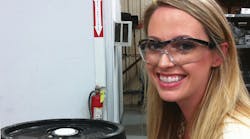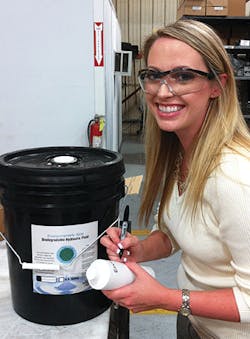After spending four days at Houston’s Offshore Technology Conference, my feet were killing me. I decided to ride the tram from the parking lot to the show in an effort to conserve what little feeling I had left in my toes.
Two gentlemen on the tram struck up a conversation, and the man beside me explained that he represented a manufacturer of triplex pumps, capable of pressure to 20,000 psi. This sounded intriguing because I had just finished a project where I specified some triplex pumps, so I asked, “What kind of flow can you get at that pressure?”
The man snapped his head toward me, eyes wide.
“Oh, sorry,” I said quickly. I hadn’t meant to interrupt.
He continued to stare at me for a moment before he answered, “About six-and-a-half gallons a minute.” He shook his head. “Sorry. I just didn’t expect a question like that to come out of you.”
I shrugged and smiled. No one ever did.
When I first started in hydraulics, I was told that this business was a “good ol’ boys” network. That didn’t faze me. My coworker and mentor warned me I would face such obstacles and shouldn’t allow them be a crutch. He took me on sales calls and wouldn’t give me answers without making me try to find them myself in books. With his assistance and no small amount of studying, I was able to earn Hydraulic Specialist Certification from the International Fluid Power Society and earn a promotion to outside sales.
Being a woman in the hydraulics business certainly has its challenges. There are the simple things most people don’t consider—like the ridiculously limited selection of women’s steel-toed shoes. But a far greater challenge is earning the respect of your clients and peers. As a female colleague and engineer once put it, “Men seem to not take me seriously until I prove myself. After I prove I’m knowledgeable, they treat me as an equal.”
Perhaps the greatest challenge I’ve found in being a female in the hydraulics industry is not an expectation of failure, but a lack of any expectation at all. However, this is slowly changing.
At each manufacturer’s training session, I am often the only woman in the room. People are genuinely surprised that I want to learn and grow in this industry. I can’t help but wonder why, and why I went into hydraulics in the first place.
I graduated from college in 2006 when the offshore industry was booming, and there were more jobs in Texas than people to fill them. I had six job offers out of school, ranging from construction to plumbing to hydraulics. When I asked my father’s advice on which job to take, he told me something I’ll never forget: “Choose the career that you think is the most challenging. It’ll never be boring, you’ll always be learning something, and if you end up hating it, you can go do something easier.”
The choice was suddenly simple. Hydraulic sales required engineering, math, and social skills. A balance of technical skill and sales savvy was needed, and I wanted to be challenged.
That’s what I emphasize when I speak about our industry to prospective graduates or interns. It’s what makes our industry so great and why I started with Hydraquip. And nearly 10 years later, I’m still here. I get to work with Ph.D.-level engineers and they look to me to help them find answers to their design problems. To me, that’s the coolest job ever.
Pumps, motors, and valves aren’t inherently exciting to me, but the solutions we can create with these components are fascinating. That’s the message we need to send to the prospective female employees in the hydraulics field.
It’s not the fault of the industry that women don’t always gravitate toward the fields of hydraulics and engineering, but it’s our prerogative to seek out intelligent, qualified women to join our team. As we develop and expand into new markets and technologies, diversity is imperative to gaining fresh ideas and differing perspectives. We do amazing things every day, and we need amazing people to join our ranks.
This file type includes high resolution graphics and schematics when applicable.



